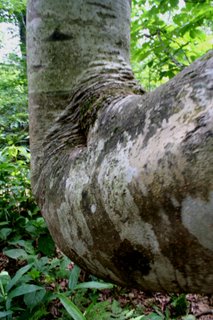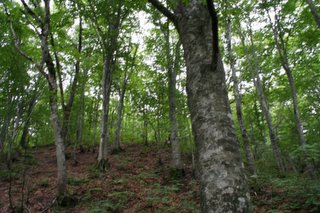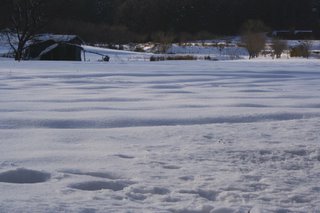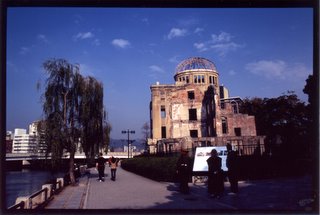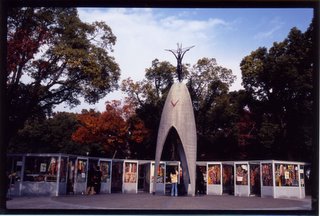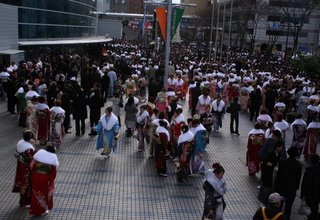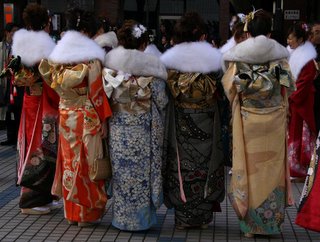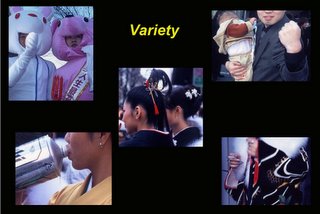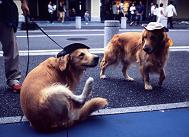Monday, January 30, 2006
Beech Tree
Shirakami is famous for Beech Forest. Last August I visited Shirakami and a local guide has shown me in the forest. He was raised in a family living on hunting (called “matagi”) and knew the forest very well like his own yard. He taught me why the beech trees turn down and then up like the following photo. They are fighting against the weight of snow. I was impressed by ttheir flexibility and hardiness. I am wondering how they are this winter.
Monday, January 23, 2006
Snow
There is a very short poem of snow, which was created by Tatsuji Miyoshi, a famous poet. I feel the quietness and warmth of snow. Try to feel the Japanese language, too.
Yuki
Taro*-o nemurase,
Taro-no yane-ni yuki-furitsumu.
Jiro*-o nemurase,
Jiro-no yane-ni yuki-furitsumu.
*Taro and Jiro are all too common names in old days.
The following are Barba’s translation.
Snow
Laying Taro to sleep,
snow lies thick on Taro's roof.
Laying Jiro to sleep,
snow lies thick on Jiro's roof.
Yuki
Taro*-o nemurase,
Taro-no yane-ni yuki-furitsumu.
Jiro*-o nemurase,
Jiro-no yane-ni yuki-furitsumu.
*Taro and Jiro are all too common names in old days.
The following are Barba’s translation.
Snow
Laying Taro to sleep,
snow lies thick on Taro's roof.
Laying Jiro to sleep,
snow lies thick on Jiro's roof.
Sunday, January 22, 2006
Winter Scenery
We had much snow yesterday even in Yokohama.

(Play with Snow)
Snow Hut and Snowman

(Berry in Red)
There is a cheerful song titled “snow” which appears in elementary school textbooks. A simple and rhythmical song! Try to sing.
 The meaning of the lyrics is shown below. (translated by Barba)
The meaning of the lyrics is shown below. (translated by Barba)Come, come, snow!
Come, come, hailstone!
Falling and falling, it lies thick.
Mountains and fields wear snow caps.
All the dead trees produce flowers.
Come, come, snow!
Come, come, hailstone!
Falling and falling, it won’t still stop snowing.
Dogs rejoice and run around the yard.
Cats snuggle under the kotatsu.*
*Kotatsu is a traditional heating appliance. A latticed wooden frame is placed over the heat source such as charcoal and a quilt covers the frame. We put both legs into the frame for warmth.
Thursday, January 19, 2006
Hiroshima
It was a movie titled “Thousands of Paper Cranes” (not sure) that I was connected to Hiroshima for the first time. The movie I watched at the primary school described a true story of a girl who had died by leukemia. She had been folding paper cranes, hoping she would be cured if she could make thousand. Second is a fiction titled “Black Rain,” but not the movie by Michael Douglas and Ken Takakura. The book a junior high school teacher recommended described a social discrimination against a young lady soaked by rain after the atomic bombing. Third is an essay “Hiroshima Notes” by Kenzaburo Oe, a Nobel Prize-winning author. This made me think what I can do. I took my children to Hiroshima. I think the Japanese more or less have such experiences through their life. Hiroshima is a place to visit once at least.
Wednesday, January 11, 2006
Inawashiro
Monday, January 09, 2006
Coming-of-Age Day
Sunday, January 08, 2006
Ritual at Tsurugaoka Hachimangu Shrine in Kamakura
I like Kamakura and I take a walk in and out of the town 5 or 6 times a year. There are a lot of nice places.
What I’ll show you today is a ritual called “Joma-Shinji.” Several years ago I happened to see this ritual at Tsurugaoka Hachimangu Shrine on New Year's Days. Minamoto-no-Yoritomo, who established the Kamakura Shogunate, moved a shrine which his ancestor had reared, and worshipped the Hachimangu Shrine as a guardian god of Minamoto family. Joma-Shinji is a rutual for a professional archery to put an arrow in the target in order to expel the evil spirits.


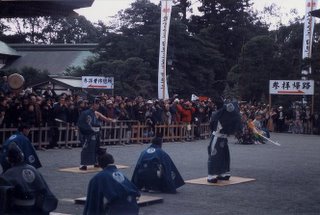
What I’ll show you today is a ritual called “Joma-Shinji.” Several years ago I happened to see this ritual at Tsurugaoka Hachimangu Shrine on New Year's Days. Minamoto-no-Yoritomo, who established the Kamakura Shogunate, moved a shrine which his ancestor had reared, and worshipped the Hachimangu Shrine as a guardian god of Minamoto family. Joma-Shinji is a rutual for a professional archery to put an arrow in the target in order to expel the evil spirits.



Wednesday, January 04, 2006
Visiting a temple
Many of the Japanese visit a temple or shrine on New Year’s Day to make wishes of the coming year. I went to Kawasaki Daishi Heikenji Temple in Kawasaki City next to Tokyo. The temple ground was crowded, though today kicked off another year of work at a lot of companies. The number of new year visitors to Kawasaki Daishi in 2005 ranks third in Japan. (Meiji Shrine ranks first.)

There are several Dharma doll shops near the temple. Dharma dolls are derived from the Buddhism sage, Dharma. The Japanese have the custom of drawing one eye on a Dharma doll when they make a wish, and drawing the other eye after they fulfill the wish. I bought a small Dharma doll. It cost 250 yen. I think the size of a doll will not affect the grace......
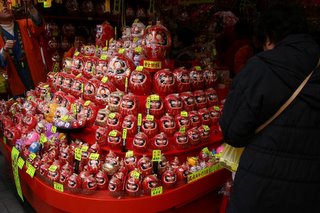

There are several Dharma doll shops near the temple. Dharma dolls are derived from the Buddhism sage, Dharma. The Japanese have the custom of drawing one eye on a Dharma doll when they make a wish, and drawing the other eye after they fulfill the wish. I bought a small Dharma doll. It cost 250 yen. I think the size of a doll will not affect the grace......

Sunday, January 01, 2006
Subscribe to:
Posts (Atom)

